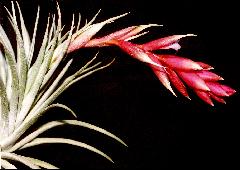
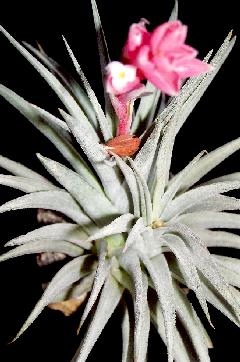
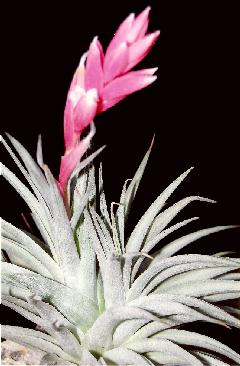
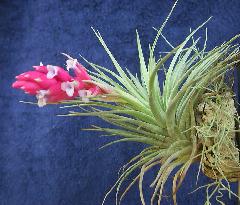
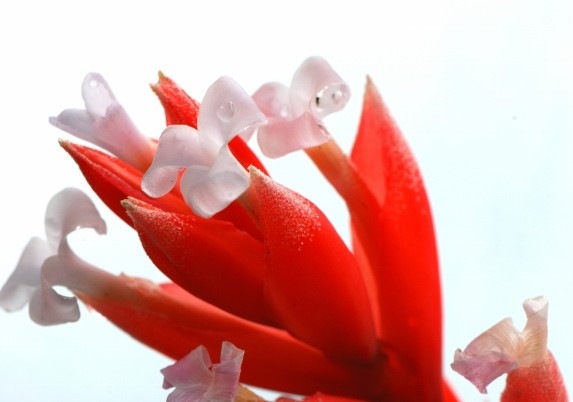
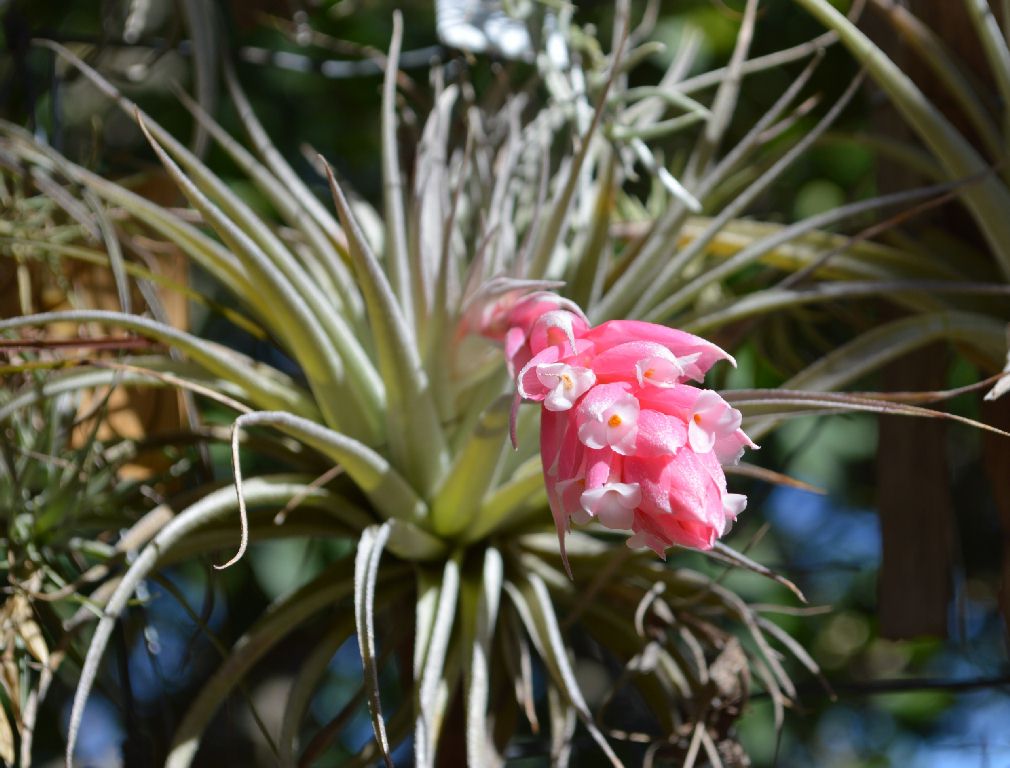
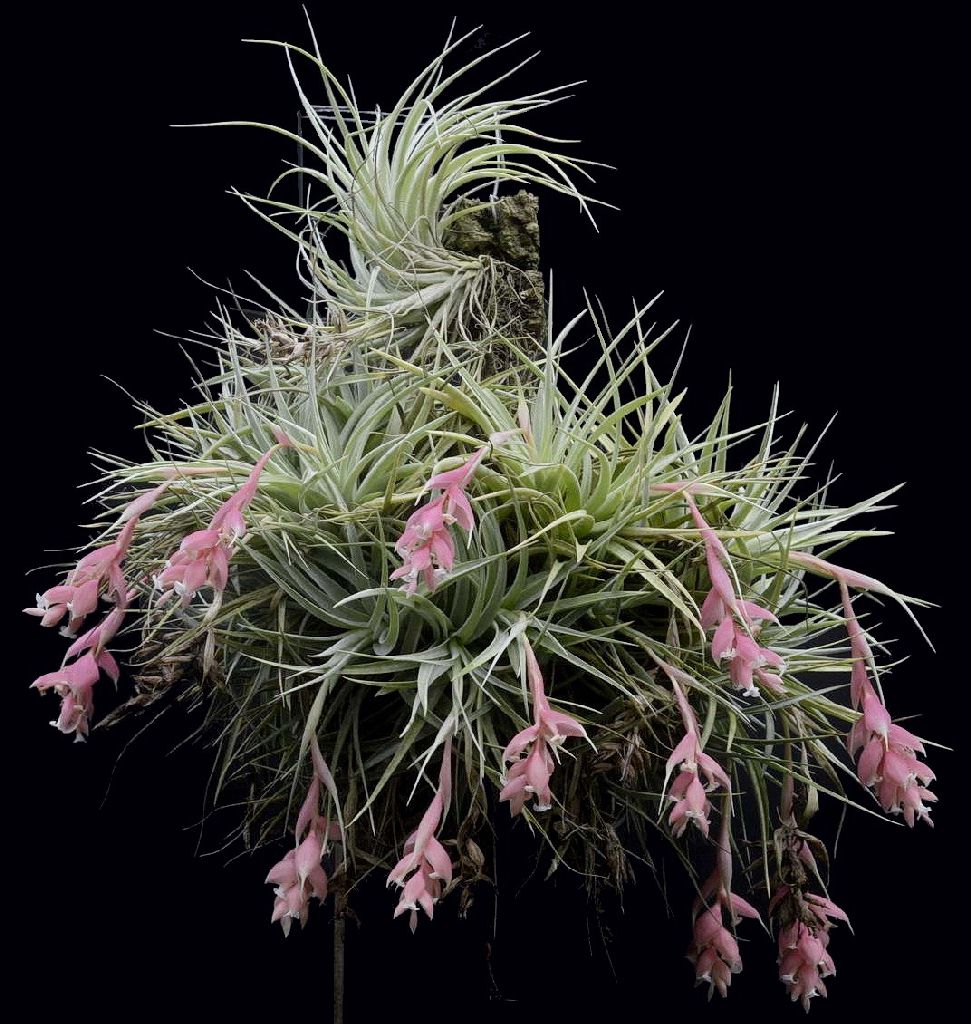
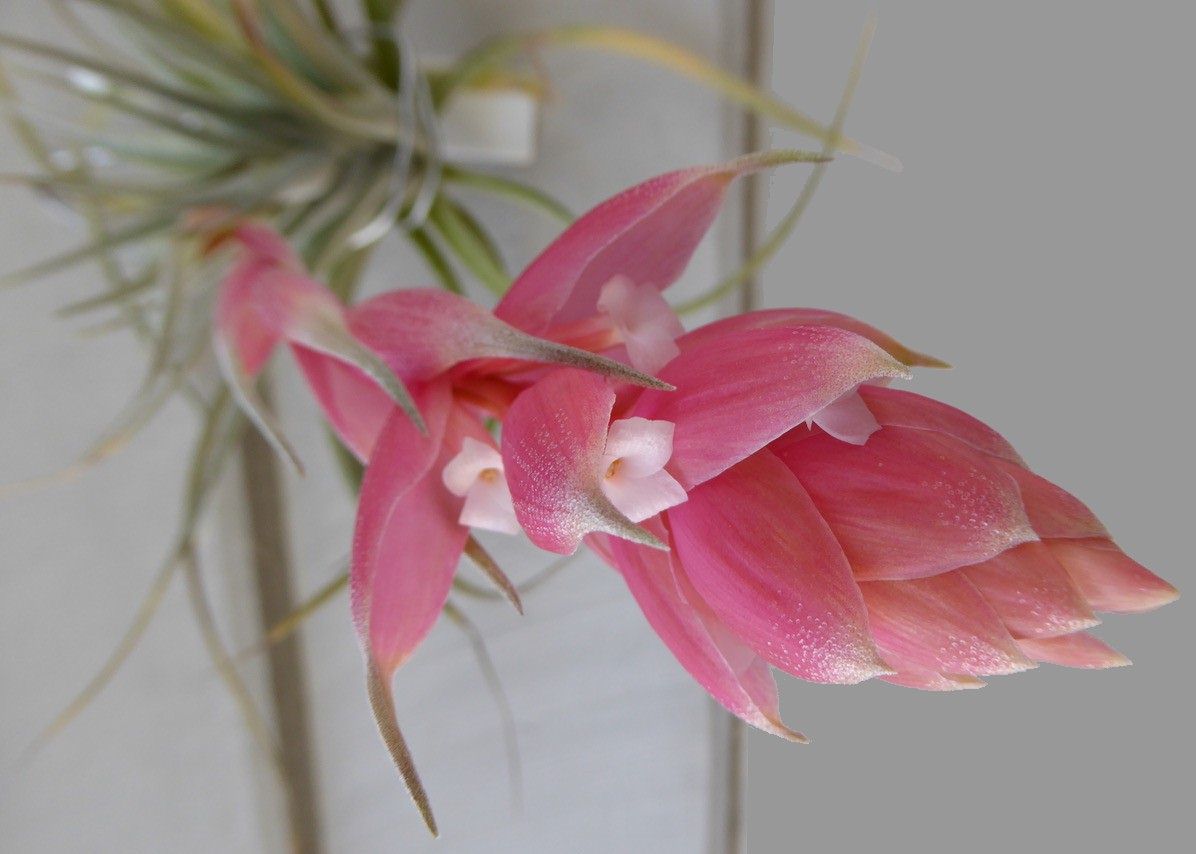
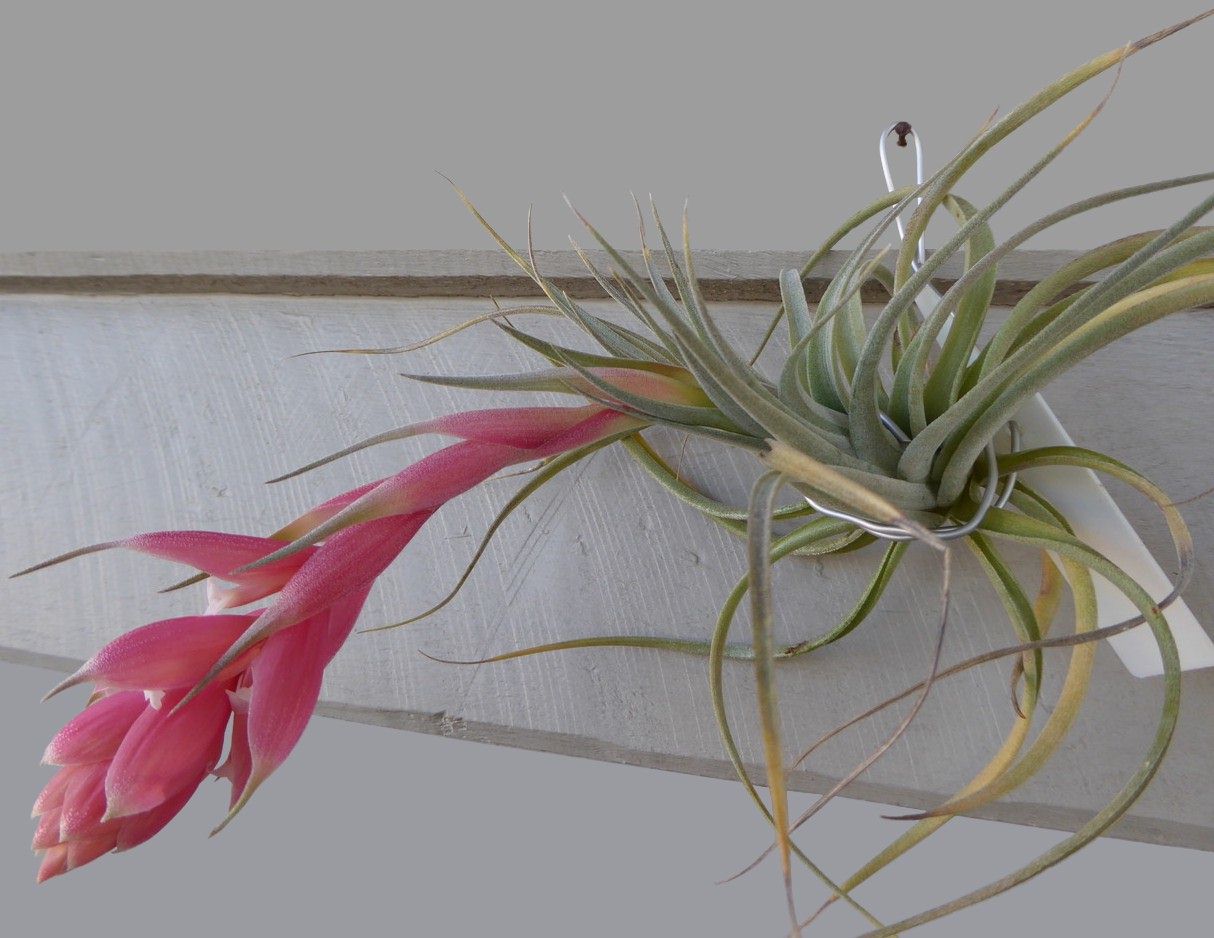
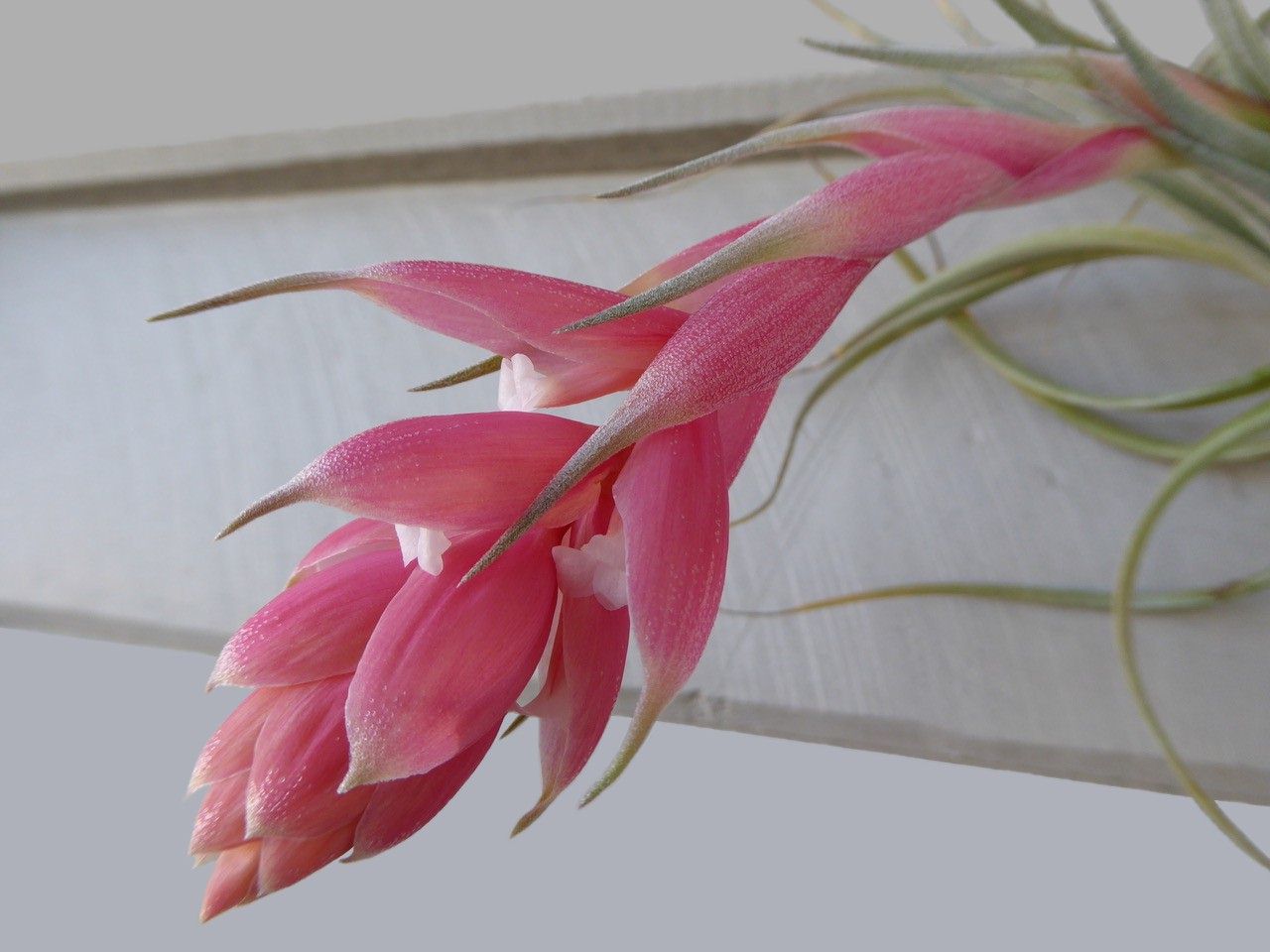
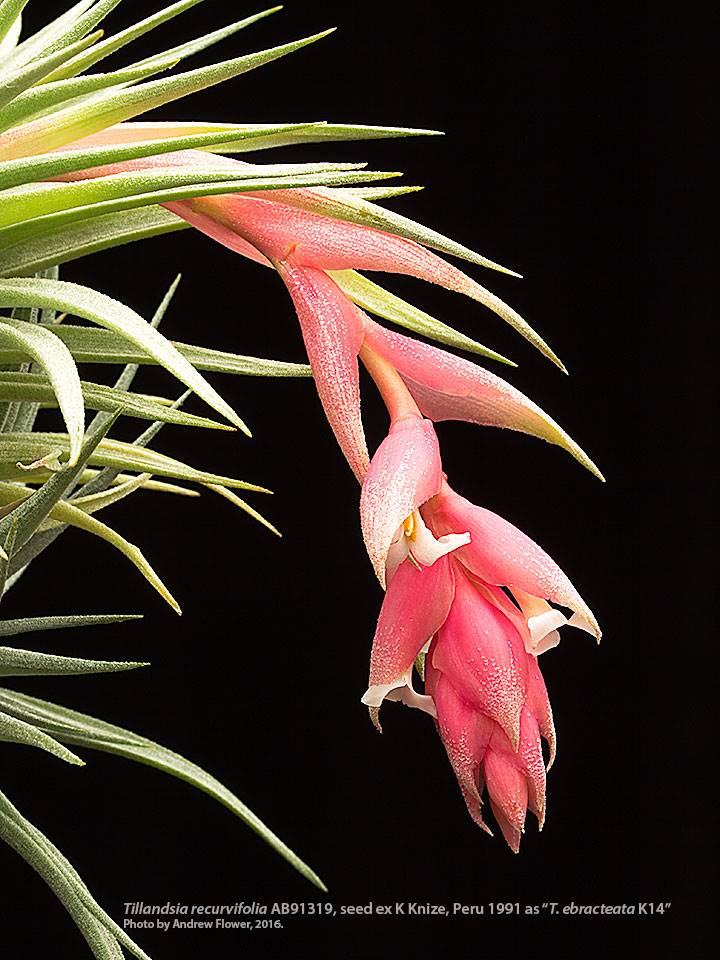
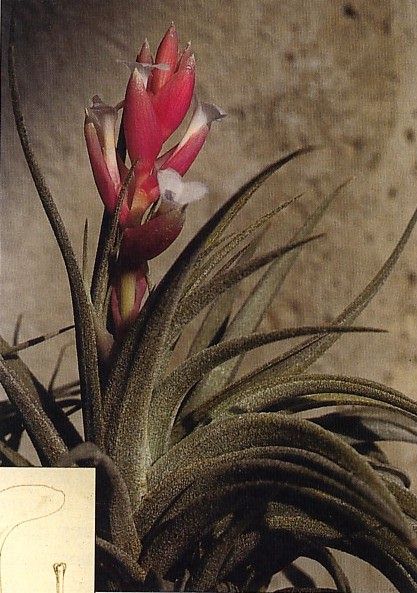
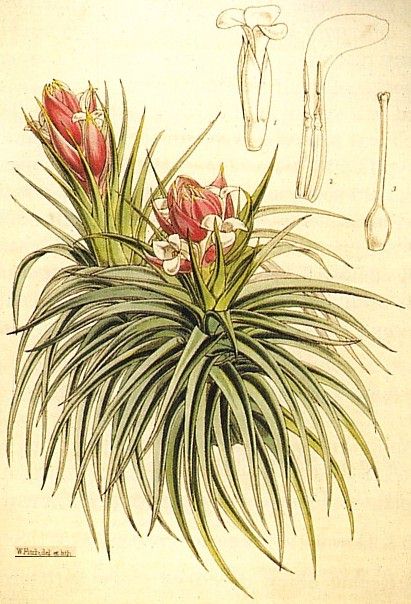
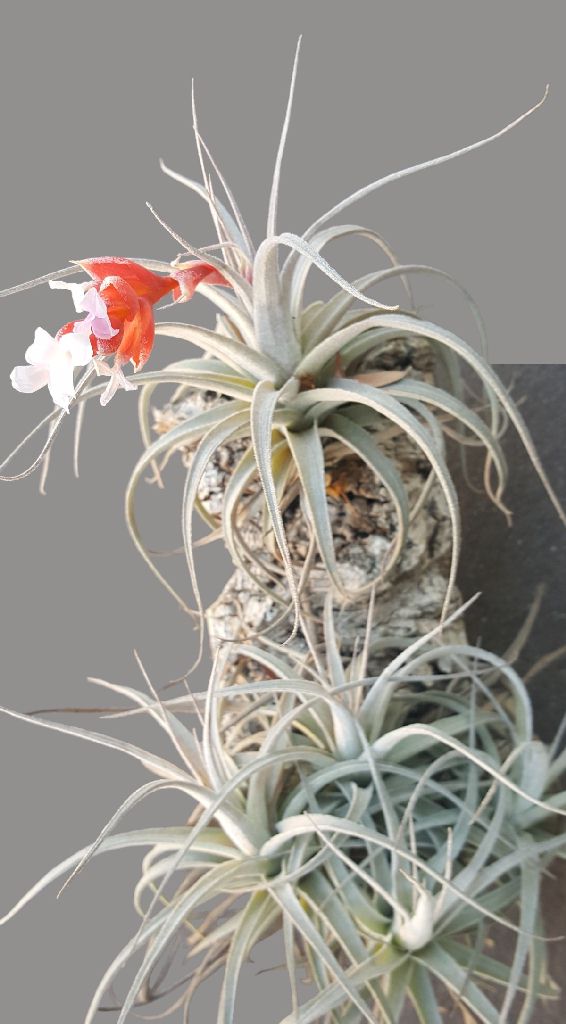
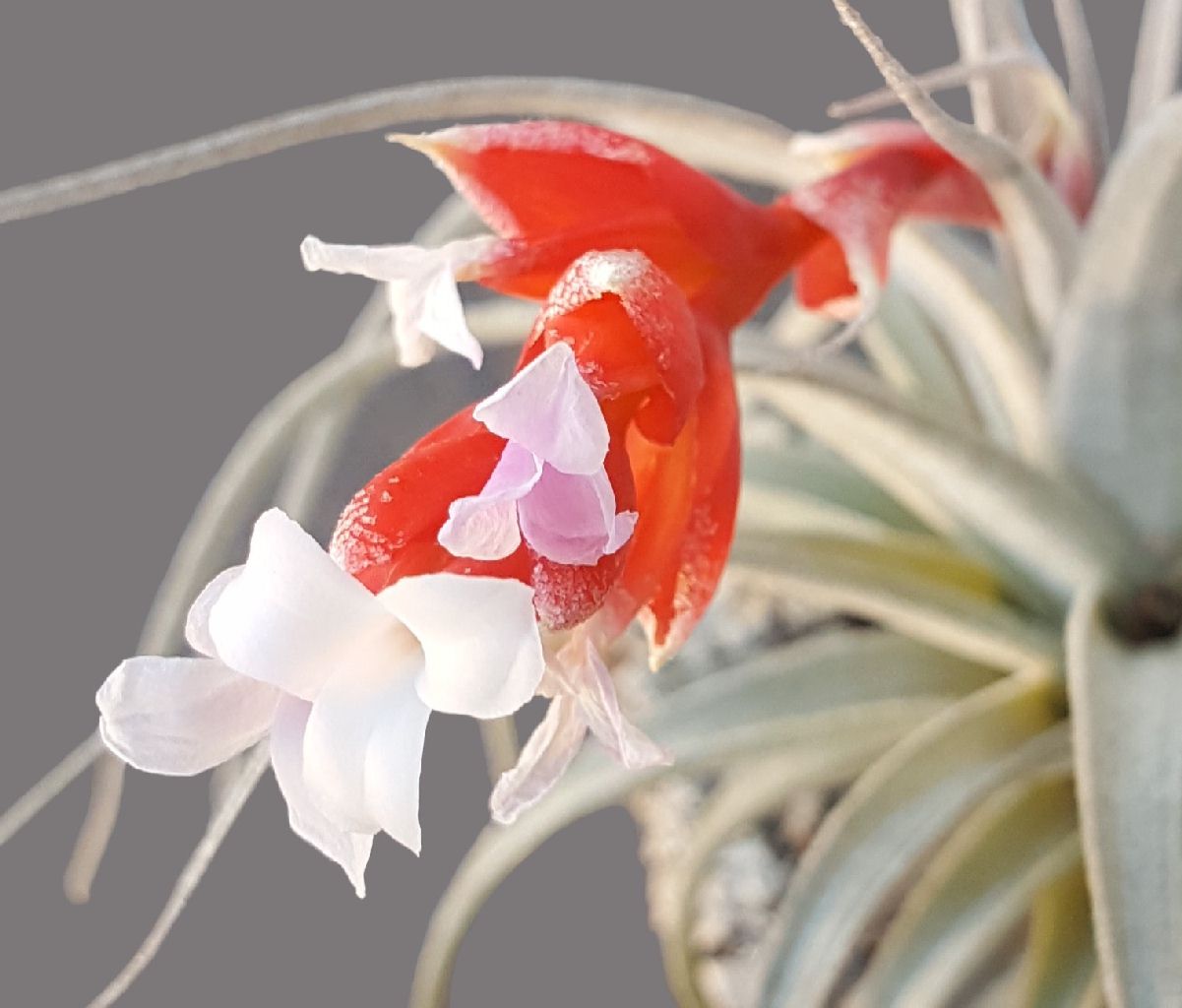
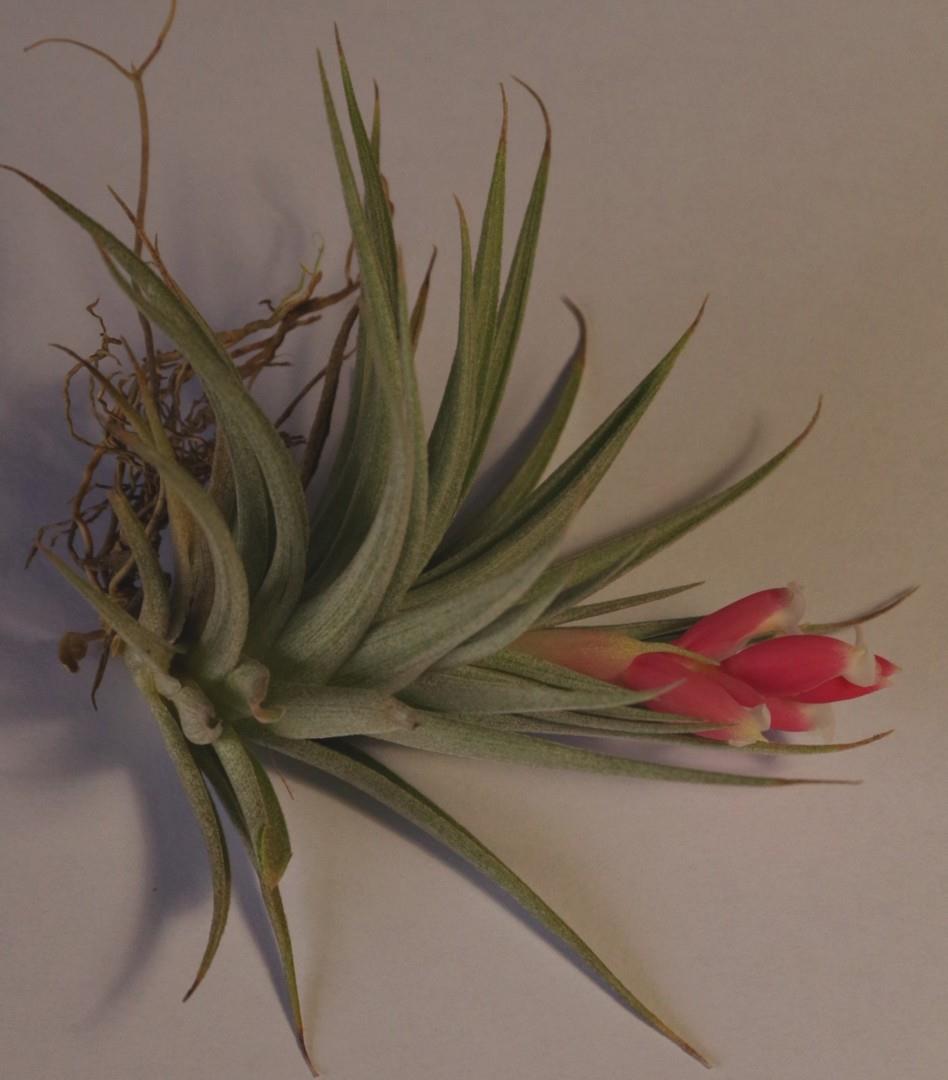
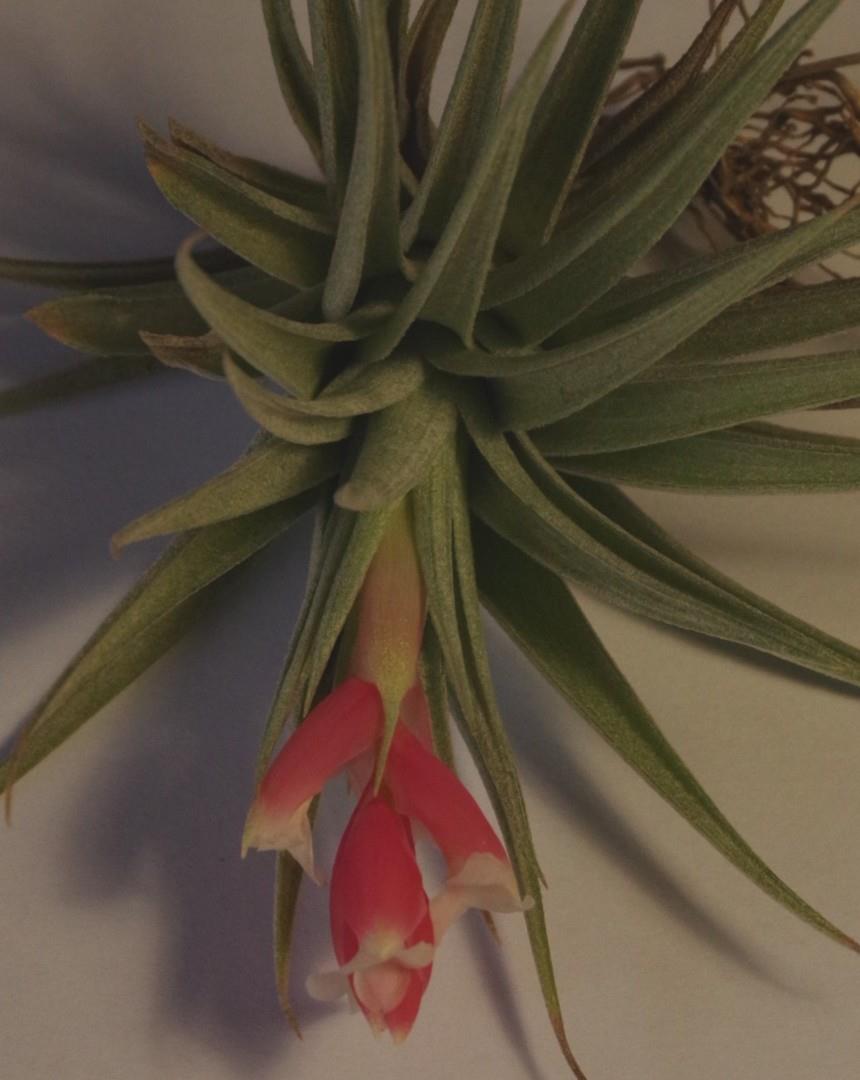
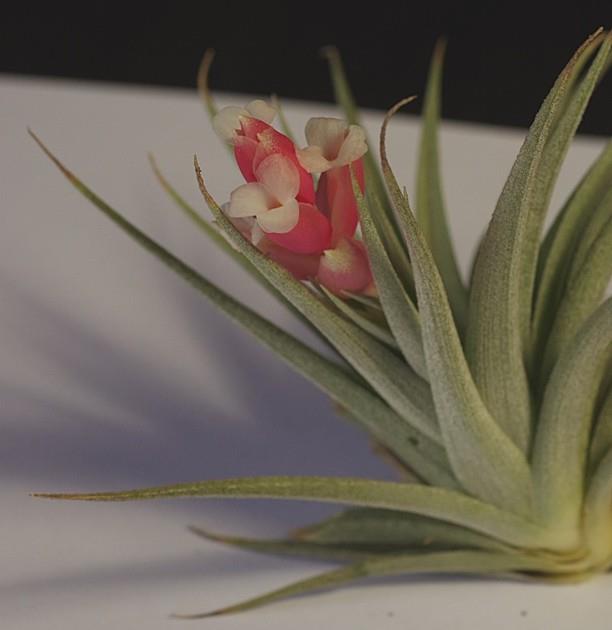
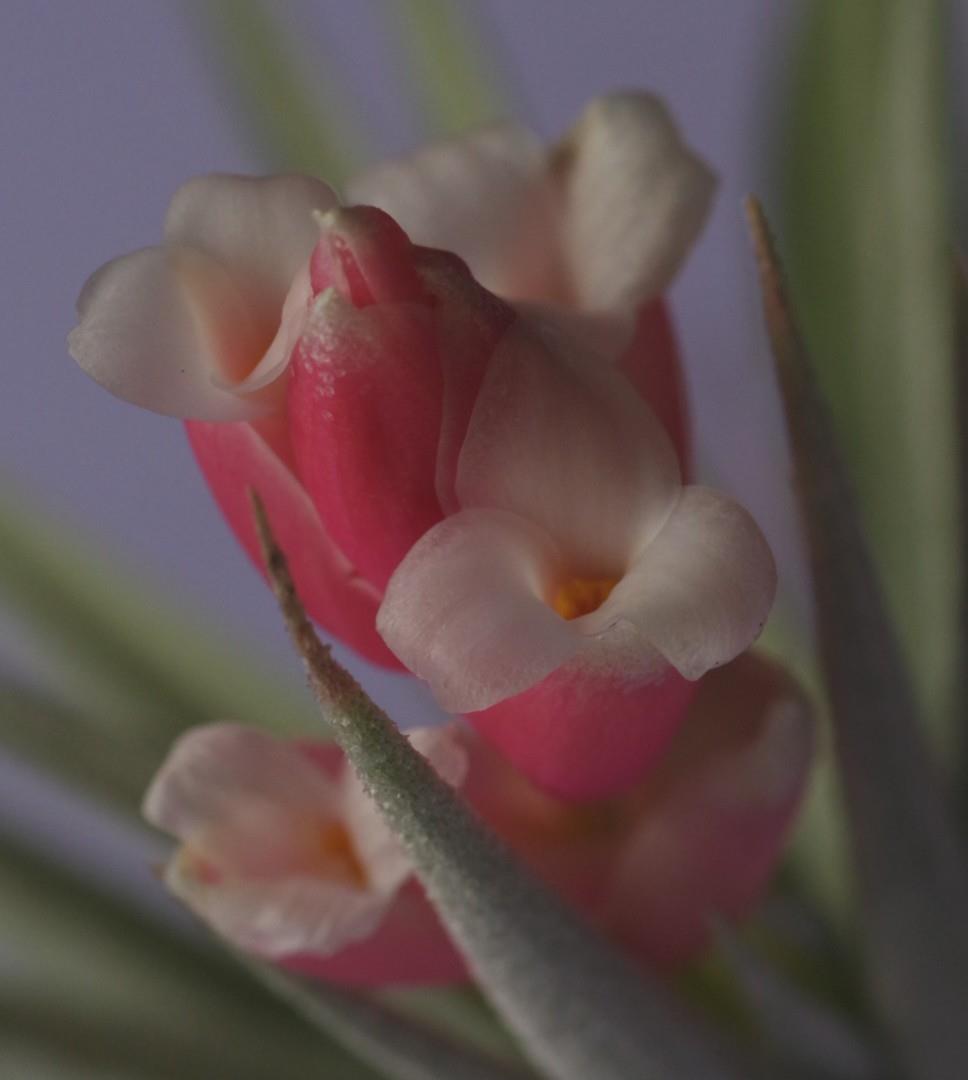
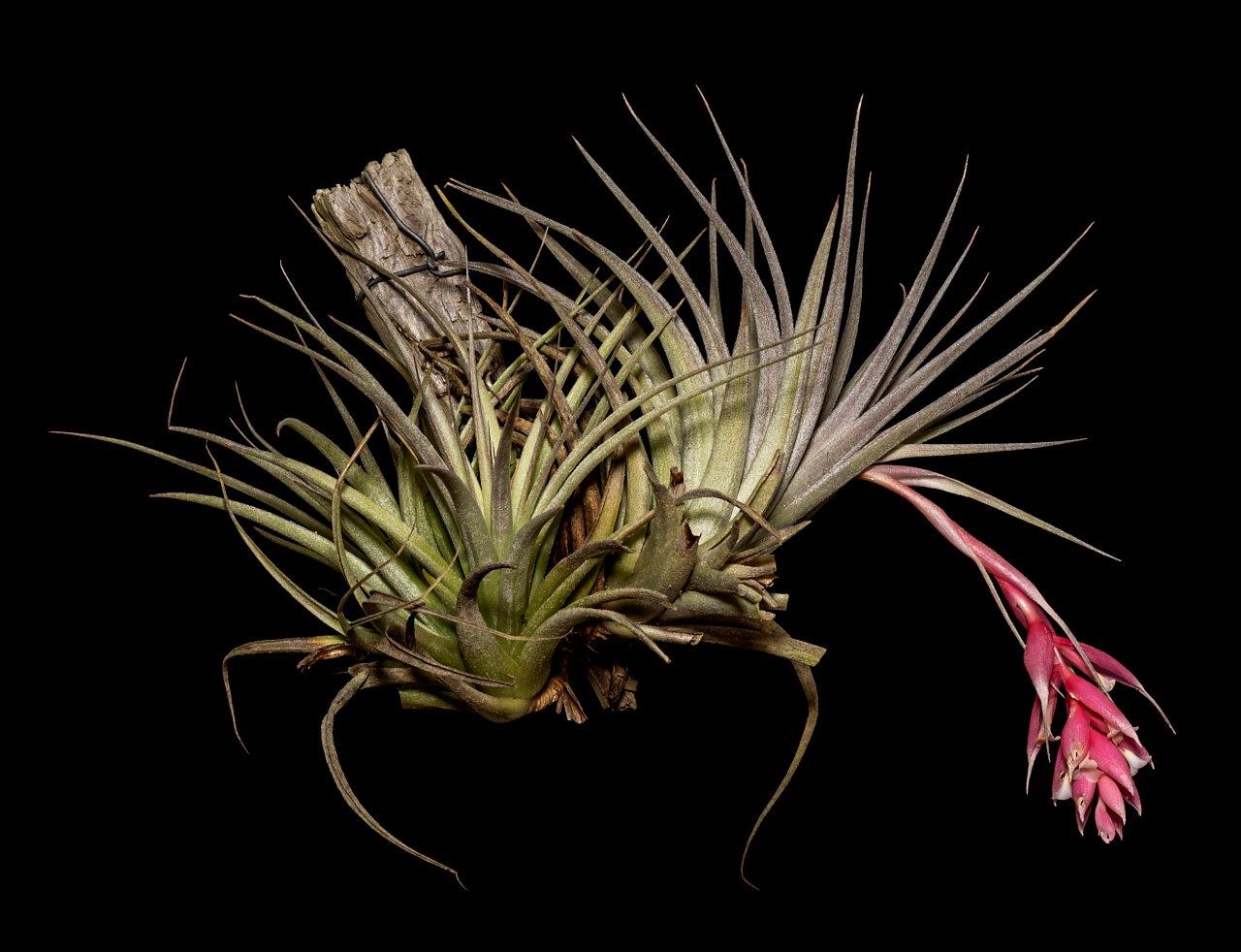
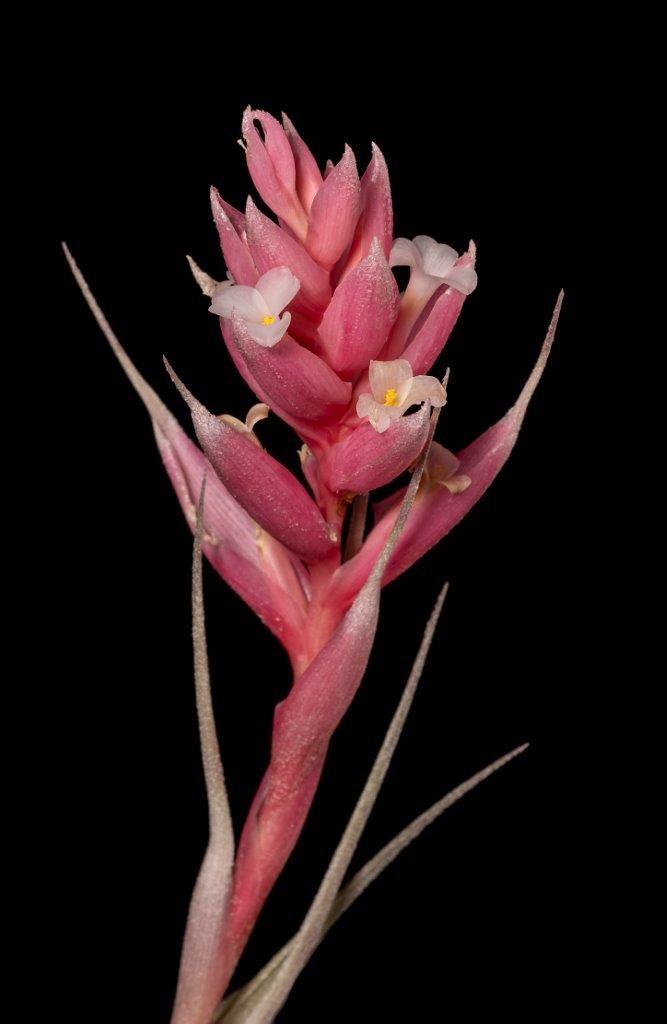
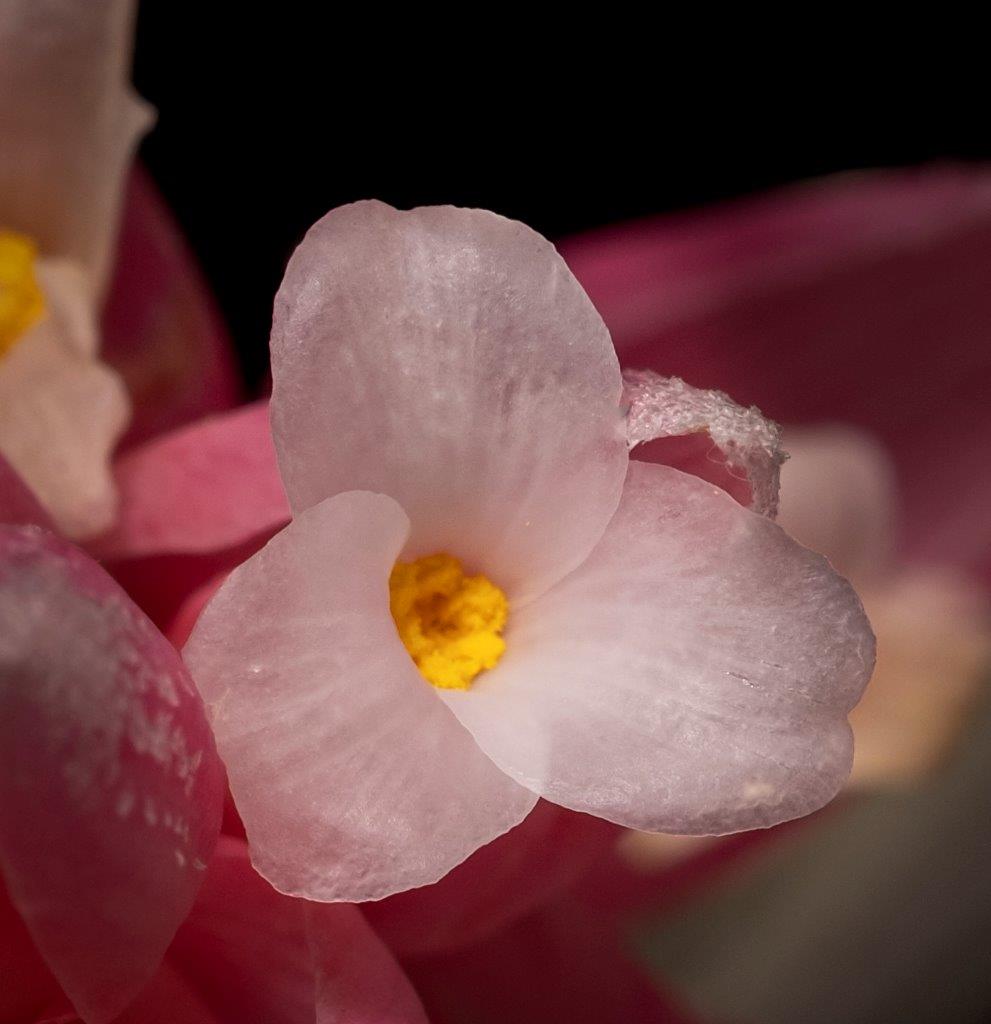
The main differences from the typical variety of T. recurvifolia are the sometimes more lax inflorescence and the orange-red floral bracts (not pink).
Plant stemless or short stemmed, flowering to 25cm high.
Leaves numerous, stiff, dark grey- green, dense appressed scaled forming an erect somewhat secund rosette.
Leaf sheath distinct, oval to 30mm long, 25mm wide, nerved.
Leaf blade narrow triangular, 10 – 13 cm long, next to the sheath 15- 20mm wide, strongly grooved, long awl like acuminate.
Scape erect, to weakly bent, to 14cm long, round, smooth, 2.5mm diam.,
Scape bracts as long as the internodes 20 – 30mm, the lower ones with awl like leafy blades, the upper ones merely an awl like tip, shorter than the inflorescence, reddish, densely scaled.
Inflorescence simple, polystichous, lax to 5 flowered, to 5cm long.
Flowers sessile, to 26mm long.
Floral bracts oval lanceolate, to 25mm long, becoming membranous, pinkish red, smooth, not keeled, the bottom with an awl like tip, the upper ones tipped and apiculate, the tip scaled, much longer than the sepals.
Sepals lanceolate, free, to 17mm long, light reddish, the tip white, the tip with scattered scales, the posterior pair with an indistinct blunt keel with a fleshy thick mid nerve.
Petals narrow lingulate, its blade longish oval and a little bent over, 27mm long, white, sometimes towards the tip a pale violet suffusion.
Stamens and Style included in the flower, Filament 15mm long, white, flat, in the middle a transverse pleat. Anthers linear, 2mm long, yellow, basifixed. Ovary globose, 2mm in diam., green, Style 15mm long, round, very thin, white, Lobes very small and contorted.
Habitat Brazil, Parana, Vila Velha, leg. Thieken s n July 1981. Flowered in the collection of Weber Aug 1981
Holotype WEB 329
Protologue
Tillandsia meridionalis Baker var. subsecundifolia W. Weber & Ehlers, Feddes Repert. 94:615, Abb. 12 (1983).
A typo differt foliis suberectis subsecundis griseo-atroviridis.
Planta acaulis vel breviter caulescens, florens usque ad 25 cm alta. Folia numerosa, rigida, atro-griseoviridia, dense subappresso-lepidota, rosulam erectam subsecundam formantia. Vaginae distincte limitatae, ovales, usque ad 30 mm longae, 25 mm latae, nervatae. Laminae anguste triangulatae, 10-13 cm longae, supra vaginam 15-20mm latae, valde canaliculatae, longe subulato-acuminatae. Scapus erectus vel leniter curvatus, usque ad 14 cm longus, teres, 2,5 mm diametiens, glaber, viridus. Bracteae scapales internodiis aequilongis (20-30 nm), inferiors subulate subfoliatae, superiores tantum subulate caudatae, breviora, quam inflorescentia, rufescentiae, dense lepidotae. Inflorescentia simplex, polysticha plus-minusve 5-flora, sublaxa, usque ad 5 cm longa. Flores sessiles, usque ad 26 mm longi. Bracteae florales ovate-lanceolatae, usque ad 25 mm longae, submembranaceae, rosaceae, leves, ecarinatae, basales subulatae, superiores acute apiculatae, etiam in apice lepidotae, multo longiora quam sepala. Sepala libera, lanceolata, usque ad 17 mm longa, pallide rufescentia, apices albida et disperse lepidota, posteriora indistincte obtuse-carinata cum nervus carnosus, Petala anguste lingulata, 27 mm longa, lamina longe-ovata, arcuato-recurvata, alba, tantum ad apices perindistinctepallide violacea suffusa, Stamina cum stylo in flore inclusa, filamenta 15 mm longa, alba, applanata, in medium transversale plicata. Antherae 2 mm longae, flavae, basifixae. Ovarium globuliformum, 2 mm diametiens, viridium. Stylus 15 mm longus, teres, albus, stigmata minutissima, contorta.
Habitat: Brasilia, Parana, Vila Velha, leg. Thieken s. n. Julius 1981, fl. Hort. Weberi 27.8.1981, Holotypus: WEB 329.
During herbarium studies at the Royal Botanic Gardens Kew (K), it became evident to W Till that the type specimen of Tillandsia meridionalis Baker is different from the plants commonly known by this name, which are treated as such in Smith & Downs (1977) and cultivated world wide. We shall refer to them as T. meridionalis auct. in the following text. There are illustrations in Baensch (1994: p. 188), Castellanos (1945: pl. 84), Gross (1992: p. 69), Isley (1987: p. 77), Kawollek (1992: p. 92), Rauh (1990: fig. 40a), Roth (1991: p. 142), Shimizu (1993: p. 24), and Smith & Downs (1977: fig. 256).
Tillandsia meridionalis auct. usually grows as an epiphyte on trees and palms, rarely is it found growing on stones. It is a species with stiff, narrowly triangular, often more or less secund, densely gray, subtomentosely lepidote leaves, and usually with an arching scape that bears a simple, polystichously flowered inflorescence. The elliptic floral bracts are rose-colored in different hues and densely lepidote at least in the apical half. They distinctly surpass the membranaceous sepals, which are equally subfree and more or less lepidote at the apex. The apically spreading petals are white (figure 12). Its distribution ranges from southeastern Bolivia and Paraguay to northeastern Argentina and the Brazilian state of Minas Gerais. The record for Bahia cited in Smith & Downs {1977, Blanchet 3524 (G)} is wrong since it represents T. stricta Sol. It has not yet been recorded for Uruguay.
The holotype specimen of Tillandsia meridionalis Baker (figure 14) in Kew is a plant with appressed lepidote leaves, the more lanceolate floral bracts are scarcely surpassing the sepals, which are adaxially half-connate and apically more or less glabrous. The plant was collected by {John} Tweedie in Banda Oriental (an ancient name for Uruguay) and the type sheet was part of the "Herbarium Hookerianum," which is now incorporated in Kew.
J.G. Baker determined the plant to be Tillandsia meridionalis and published it validly in 1888. The name is written in pencil in his characteristic handwriting on the type sheet with Anoplophytum refulgens Morren as a synonym. Six years later, C. Mez annotated the plant as "T. ixioides Gris." and stated, "specimen giganteum, sed nullo modo separandum! a T. refulgens Morr. toto coelo divisum!" ' Although W Till in 1983 followed the opinion of Mez (1894) in determining the type as T. ixioides, he no longer agrees.
The type specimen, further, bears a letter of Edouard Morren to Baker with the following comment (translated): "Liege, 21 April. Dear friend, your Anoplophytum seems to be new to me - with the reservation of only an examination in the herbarium. If you agree, I would name it A. refulgens, as if it were opalescent, because of the striking nacreous bracts, two words that do not exist in Latin. As for the 8th of October, I do not say no. We shall see what will be possible. At that time it could be manageable. In friendship, E. Morren. I will travel on Tuesday to Basel, Zurich, and Zermatt:"
At the moment it remains open to discussion whether Tillandsia meridionalis Baker is a synonym of T. aeranthos (Loisel.) L.B. Smith or a distinct taxon. It is, however, doubtlessly distinct from T. meridionalis auct., which, therefore, requires a new identification.
There is only one synonym under Tillandsia meridionalis in Smith & Downs (1977): T. stricta Sol. var. paraguariensis Hassler. This plant, however, differs from T. meridionalis auct. in the appressed indument of the leaves and the violet petals and, hence, cannot be used as the basis for a new name of our plant in question.
Anoplophytum refulgens was interpreted by Baker in a different sense than perhaps intended by Morren and is a mere name in the synonymy of T. pohliana Mez as are the validly published T. latisepala L.B. Smith and T. windhausenii Hassl. ex Rojas. In checking the nearest related species {T. stricta Sol and T. rosea sensu Smith & Downs (1977)}, the most conformity was found with T. recurvifolia Hook, (figure 13), which was treated as a synonym of T. rosea and to a smaller extent with T. hilaireana Bak., which was treated as a questionable synonym of T. pohliana Mez. T. recurvifolia is typified by plate 5246 of Hooker's Botanical Magazine, T. hilaireana by the herbarium specimen of Saint-Hilaire 508, which was studied by H. Luther in 1992 and subsequently by W Till. Saint-Hilaire #508 in Paris (herbarium P, isotype) bears two plants with nearly glabrous floral bracts and glabrous sepals that are adaxially connate for one third. Its identity cannot be discussed at the moment as there is no living material available that is in full accordance with the type of T. hilaireana. Consequently, we do not consider it to be a synonym of T. recurvifolia.
We propose that the following is the valid and correct name for Tillandsia meridionalis auct. non Baker:
Tillandsia recurvifolia Hooker,Bot. Mag. pl. 5246 (1861).
Type: original description and plate in absence of any herbarium specimen. Syn. T. meridionalis sensu Smith & Downs 1977 et auctorum, non Baker 1888. In 1983, Wilhelm Weber and Renate Ehlers described a new variety of T. meridionalis auct. from the Brazilian state of Parana: var. subsecundifolia W Weber & Ehlers. The main differences from the typical variety of T. recurvifolia are the sometimes more lax inflorescence and the orange-red floral bracts (not pink). The plant illustrated in Shimizu (1993: p. 21) under #71 as T. leonamiana Pereira, is a certainly distinct taxon. For this variety the following new combination is proposed:
Tillandsia recurvifolia Hooker var. subsecundifolia (W Weber & Ehlers) W Till, comb. nov.
Type: original description and plate in absence of any herbarium specimen. Basionym: T. meridionalis Baker var. subsecundifolia W Weber & Ehlers, Feddes Repert. 94:615, Abb. 12 (1983).
We are grateful to the directors of the herbaria G, K, and P for making their valuable specimens available for this study.
When Professor John Lindley first described Tillandsia rosea in the Botanical Register Vol. 16 (1830) and pictured it on plate 1357 he certainly could not have foreseen the confusion over this species in the next 150 years and the difficulties it would make for the various taxonomists as they tried to categorize it and interpret it. Especially in the years following the second world war, in which tillandsia collecting really became popular, the most varying species and forms have been and still are being seen as the "true" rosea and are being sold at prices that boggle the imagination. Only in the last two years, thanks to the rewarding collecting efforts of Mr. and Mrs. Hromadnik (Austria) and Mr. and Mrs. Ehlers (Federal Republic of Germany), have we been able to study blooming, living material and make comparisons, so that now there is finally a certain clarity about the classification of T. rosea and the species considered to be identical with it as far as can be determined in the face of missing type material.
But let me first depict the separate steps of this learning process as far as it has developed historically and has precipitated into the professional literature. So that the reader may be able to trace this path, I have included with this article the illustrations of the original plates and photographs of the species considered to be T. rosea Lindl.
We begin our investigation with the original description by John Lindley in the Botanical Register:
Pink-headed Tillandsia. Tillandsia rosea; foliis ligulatis acuminatis furfuraceis patentibus, spica ovata solitaria foliis vix longiore, bracteis ovatis concavis.
This extremely terse Latin description says: leaves ligulate, pointed, mealy (referring to the scale covering), spread; spikes oval, single, barely longer than the leaves; bracts oval, concave.
Then Lindley adds: "Our drawing of this undescribed species of tillandsia was made some years since, from a plant in the possession of the Marchioness of Bath. It flowered in the month of May, but having afforded only a single specimen, we had not an opportunity of examining it in detail. It is, however, distinguished sufficiently by its ovate head of flowers scarcely higher than the leafs, and bright pink bracteae. A native of Brazil."
So much for Lindley's original description. Along with plate 1357 it is considered to be the type, since no herbarium specimen was kept. Note particularly that no information is given in the description about the flowers themselves and their color and that the flowers are also not shown on the plate!
The next step was the Austrian botanist J. G. Beer's description of our species in his book Die Familie der Bromeliaceen (1859) as Anoplophytum roseum: He considered the present-day subgenus Anoplophytum to be a separate genus. But he described it only from the picture and Lindley's text in the Botanical Register. He had no living plants or herbarium specimens at his disposal.
Then 32 years later in Baker's Handbook of the Bromeliaceae (1889) we find Tillandsia rosea Lindl. 1830 together with Tillandsia recurvifolia listed as synonyms of Tillandsia dianthoidea Rossi (= T. aeranthos). The description of the flower color of T. rosea as white, which has subsequently always been repeated, begins with this listing in Baker's book. Tillandsia recurvifolia was described by Hooker in the Botanical Magazine Vol. 87 and pictured in plate 5246. His original description is as follows:
Recurved-leaved Tillandsia. Tillandsia recurvifolia; foliis glaucescenti-lepidotis, e lata basi lanceolato-subulatis canaliculatis integerrimis, radicalibus insigniter recurvis, floralibus erecto-subpatentibus minus glaucis spicam aequantibus, scapo folioso brevissimo, spica late ovata subcapitata laxe bracteata, bracteis elliptico-oblongis acutissimis roseis, calycis albi laciniis lanceolatis mucronato-acutis basi in tubum unitis, corollae albae petalis spathulatis stamina superantibus filamentis supra medium crispato flexuosis.
This is, as far as I can find, a new species of Tillandsia, evidently of the same group as, and nearly allied to, the pretty T. pulchella, figured in a late number of this Magazine, Tab. 5229, differing in the much broader, very glaucous, all very much recurved leafes, in the larger, almost sessile, and nearly ovate spikes of flowers, with much broader and pink-coloured, not red, bracts. We owe the possession of it to our friend, W. D. Christie, Esq., British Minister at Rio, who introduced it to Kew Gardens from Panama. I have already remarked, that easily as the Tillandsiae are to import living, and tenacious as they are of life, no plants are more difficult to preserve in cultivation for any length of time.
Descr. Stemless. Radical leaves copious, densely imbricating at their broad base and thence becoming lanceolato-subulate, three to four inches long, channelled, thickly clothed with minute scales, which give them a hoary and very glaucescent appearance; the interior and superior leaves, which immediately surround the inflorescence, are more erect, less glaucous, but broader, in proportion to the length, at their base. Scape very short, leafy, terminated by a broad ovate spike or capitulum of flowers, laxly imbricated with large broad-oblong, very acute, rose-coloured scales, sometimes tipped with yellowish-green. The white flowers force back the rose-coloured bracts, and protrude a very little beyond them. Calyx of three erect imbricating almost mucronate sepals, nearly as long as the corolla, united into a tube at their base. Petals pure white, with a spathulate limb and broad white claws. Stamens as long as the claws. Filaments linear-subulate, crisped and tortuose above the middle. Anthers small, linear. Ovary ovate, tapering into a thickened style, and terminated by three cuneate nearly erect stigmas. MAY 1st, 1861."
But as far as is known no herbarium specimen of T. recurvifolia Hook. 1861 was preserved, so that here too the original description and plate must serve as the type.
In contrast to Baker, Carl Mez considered Tillandsia rosea Lindl. 1830 as a variety of Tillandsia pulchella and described it in Martii Flora Brasiliensis III. 3. (1894) p. 603 and also in his first bromeliad monograph in DeCandolle, Monographiae Phanerogamarum Vol. 9 (1896) p. 825 as Tillandsia pulchella var. rosea. As synonyms he listed T. rosea Lindl. 1830, Anoplophytum roseum Beer 1857 and T. recurvifolia Hook 1861. As a habitat he cites Guyana (?) and also lists the following herbarium documentation: Bolivia, ad Soratam, alt. 2650 m: Mandon n. 1184, M. Bang n. 1628. According to L.B. Smith in Flora Neotropica (1977) these two specimens are identical with T. tenuifolia L.
However, in his second monograph in Engler's Pflanzenreich (1935) Carl Mez again cites T. recurvifolia Hook. as valid and further lists as synonyms T. langsdorffii Mez 1894 (?), T. rosea Lindl. 1830, Anoplophytum roseum Beer 1857 and T. pulchella var. rosea (Lindl.) Mez 1894. As herbarium documentation he cites only the specimen in the Leningrad herbarium, which was the basis of his description of T. langsdorffii in the Flora Brasiliensis in 1894, and adds: "As a habitat Panama is cited; this is incorrect. The plant comes from Brazil, state of Rio de Janeiro (Langsdorff)." Compare this habitat information (Panama) above to that of the original description of Tillandsia recurvifolia Hook. 1861; I will return to this fact at the end of the article.
This is the extent of the knowledge about our mysterious T. rosea Lindl. shortly before the second world war, and just 10 years after the end of the war we find it revalidated by L. B. Smith in Bromeliaceae of Brazil (1955) and synonyms Anoplophytum roseum (Lindl.) Beer 1857, T. recurvifolia Hook. 1861, T. langsdorfii Mez 1894 and T. pulchella var. rosea (Lindl.) Mez 1894 listed. As herbarium documentation he cites: Rio de Janeiro: Langsdorff (LE) and Teresopolis: Brade and Pereira 20062 (RB, US).
Now we have arrived at the time when the Bromeliad Society was founded and bromeliad cultivation spread quickly in America and in Europe and great collections of living plants came about outside the botanical gardens. More and more growers have done their own collecting in the tropics and plants have appeared designated the "true T. rosea," among which is a hard, secund-leafed tillandsia, which grows along with T. sprengeliana on vertical cliff sides in the Organ Mountains near Rio de Janeiro. Alfred Blass presented it as Tillandsia rosea Lindl. in the Journal of the Bromeliad Society Vol. 28 (1978) p. 32-34 with a color photograph. The same species was earlier pictured in Walter Richter's book Zimmerpflanzen von heute und morgen - Bromeliaceen as T. regnellii.
If one compares the illustrations of this plant with Lindley's original plate from the Botanical Register one easily sees that it is not identical with T. rosea Lindl. 1830! This tillandsia was described by Walter Till in Plant Systematics and Evolution 138 (1981) p. 293-295 as Tillandsia carminea sp. n., holotype: Brazil, State of Rio de Janeiro, Serra dos Orgaos SE of Teresopolis, 1950 msm, leg. Dr. H. et L. Hromadnik Nr. 6160, Aug. 1980 (WU). I also have at my disposal a topotype of this species, leg. R. Ehlers, 1900 msm, July 1981 (WEB 265). In the second edition (1981) of Prof. Rauh's book Bromelien, Tillandsia carminea Till 1981 is still described as T. rosea Lindl. 1830 and pictured in a black-and-white photograph; but again the white flowers are mentioned. T. carminea, however, blooms blue-violet as does T. stricta and based on the flower parts is hardly distinguishable from it.
In L. B. Smith's monograph in Flora Neotropica 14.1. (1977) p. 822, T. rosea Lindl. 1830 is still cited as valid and as synonyms are given Anoplophytum roseum (Lindl.) Beer 1857, T. recurvifolia Hook. 1861 and T. pulchella var. rosea (Lindl.) Mez 1894. On the other hand T. langsdorffii Mez 1894 has been removed from the list of synonyms. The accompanying photograph of the Leningrad type specimen of T. langsdorffii reveals at the bottom right that L. B. Smith was able to examine this type only as late as 1959 and determined it to be identical with T. stricta Sol. ex Ker-Gawl. 1813. As herbarium documentation of T. rosea he cites: Brazil, Rio de Janeiro, Serra dos Orgaos, Teresopolis, Sept. 1949, Brade and Pereira 20062 (RB, US): April 1959, Abendroth 109 (US); 117 (US); Ponta do Forte, Arraial do Cabo, Cabo Frio, Jul. 1965, Segadas-Vianna 4320 (R, US). An hatch drawing after Segadas-Vianna 4320 is reproduced as Fig. 258 D - E, but here, too, a comparison with Lindley's plate shows that the two are not identical.
In 1981 Frau Renate Ehlers scoured the cliff walls of Cabo Frio for tillandsias that could be identical with T. rosea Lindl. but found only T. sprengeliana and the same saxicolous form as Segadas-Vianna 4320; the latter, however, after careful studies has been found to be identical with Tillandsia neglecta Pereira 1971, described in Bradea 1, p. 78, pl. 2, holotype: Cabo Frio, D. Sucre s.n. (HB 50230).
In Flora Neotropica L. B. Smith places T. neglecta Pereira as a synonym for T. tenuifolia var. surinamensis (but with a question mark). The specimens which I examined (WEB 324 and living material, leg. R. Ehlers, Jul. 1981, Cabo Frio) regularly show, however, only a few fused sepals and accordingly do not belong to the polymorphic T. tenuifolia, whose posterior sepals are always fused. T. neglecta Pereira is more probably related to T. stricta Solander ex Ker-Gawler 1813, but distinct from it. (The original description of T. stricta Sol. is designated with G. According to information from Dr. Vickery, British Museum, that is the sign of Ker-Gawler).
We have now determined that a "true" Tillandsia rosea Lindl. cannot be identified up to this point. So what sort of plant had Lindley described and pictured? In contrast to the earlier taxonomists we today are in the lucky position of being able to study and compare a large number of living plants in collections. For example, a population of the variable T. stricta is found near Teresopolis, which in its non-blooming stage totally resembles Lindley's picture. It also has the short flower scape, so that the inflorescence is hardly longer than the leaves, a feature which is considered significant for T. rosea along with the white flowers. Walter Till also mentions that in the introduction to his description of Tillandsia carminea and he writes: "In examining the original description of T. rosea Lindley (1830) it has been determined, however, that the plant is merely a T. stricta Solander not yet in full bloom. An examination of L. B. Smith's (1977) listing of synonyms for T. rosea, T. pulchella Hooker var. rosea (Lindley) Mez in Martius and T. recurvifolia Hooker has shown that both belong to the quite variable T. tenuifolia L. Thus it was necessary to withdraw the name T. rosea and to describe the present species anew."
But Herr Till is mistaken here insofar as T. pulchella v. rosea cannot be considered a synonym for T. tenuifolia, because Mez based his T. pulchella var. rosea on T. rosea Lindl., and if this becomes synonymous with T. stricta then automatically T. pulchella var. rosea, and Anoplophytum roseum Beer also become synonymous with T. stricta, but not T. recurvifolia Hook. 1861, whose identity we have not yet clarified!
Thus the synonym list for T. stricta should be extended as follows:
Tillandsia stricta Solander ex Ker-Gawler 1813
adde Syn.: T. rosea Lindley 1830
- Anoplophytum roseum Beer 1857
- T. pulchella var. rosea (Lindl.) Mez 1894
- T. recurvifolia sensu Mez et alior p.p., non Hooker 1861.
Tillandsia stricta has long been known as the most common Brazilian tillandsia and it is baffling to us today that Lindley described a T. stricta not yet in full bloom. The solution to the puzzle is probably that Lindley in his time did not know T. stricta and mistakenly described in 1830 in the Botanical Register with an illustration on plate 1338 Till. aeranthos as T. stricta, and thus the real T. stricta must have appeared new to him and he described it as T. rosea.
Now we must explain which species Hooker described as T. recurvifolia. As we saw, Hooker in his description said that it was closely related to T. pulchella (today T. tenuifolia), and this remark probably caused Till to think of it as a synonym for T. tenuifolia. But if we observe the sentence in the description "Calyx . . . united into a tube at the base", and compare the depiction of the flowers with the sepals (fig. 1), then we see clearly that the sepals are in today's parlance "equally subfree or short connate," and that the inferior sepals are not at all fused highly as in T. tenuifolia! On this point the identity of T. recurvifolia is clearly distinguished from T. tenuifolia.
The habitat citation is also puzzling. Hooker writes that the plant was sent to Kew from Panama by W. D. Christie. But as mentioned above, Mez excluded this possibility. Now a comparison of citations of other herbarium specimens of various Bromeliaceae shows that Christie never collected plants in Panama, but had collected several in Parana! In Hooker's time there were no typewriters and Hooker's handwritten manuscript was possibly the cause of this distortion by the typesetter.
Now the area of the species in question is narrowed to southern Brazil and Argentina. (Christie also collected T. vernicosa and T. ixioides with the notation "Parana". According to the distribution of T. ixioides, then, the note does not refer to the Brazilian state Parana and not to the river either, but probably to the city Parana in the province Entre Rios in Argentina!) From these two areas the only white-flowered tillandsias of this general form would be an albino form of T. stricta or T. meridionalis. The white-flowered T. pohliana Mez is clearly different and can be excluded. But for an albino T. stricta the petals appear to be too wide and too recurved. Also for T. stricta the long, awl-like blades of the lower flower bracts are missing. There is a closer resemblance to T. meridionalis Baker 1888 - except for the atypically short inflorescence scape, which, however, may have been somewhat stunted by transporation conditions and cultivation in Kew. We note this phenomenon even today in some plants that have not received optimal care.
A difference still not explained is the unmentioned typical scaling of the sepals in T. meridionalis. But this can stem from the fact that the depiction of the scaling afforded difficulties to the artist. Even on the leaves there is no indication of scaling in the drawing, although Hooker mentions them expressly in his description. Hooker may have overlooked them on the sepals or considered them insignificant. Afterall, there are forms of T. meridionalis with only slight scaling only at the tip of the sepals.
Therefore it is best to consider T. recurvifolia Hook. 1861 as probably identical with T. meridionalis Baker 1888, although there is no possibility of an exact test, since, as mentioned above, there is probably no type specimen of T. recurvifolia preserved for examination.
This is, as far as I can find, a new species of Tillandsia, evidently of the same group as, and nearly allied to, the pretty T. pulchella, figured in a late number of this Magazine, Tab. 5229, differing in the much broader, very glaucous, all very much recurved leaves, in the larger, almost scssilc, and nearly ovate spikes of flowers, with much broader and pink-coloured, not red, bracts. We owe the possession of it to our friend, W. D. Christie, Esq., British Minister at Rio, who introduced it to Kew Gardens from Panama. I have already remarked, that easily as the Tillandsia are to import living, and tenacious as they are of life, no plants are more difficult to preserve in cultivation for any length of time.
DESCR. Stemless. Radical leaves copious, densely imbricating at their broad base, and thence becoming lanceolato-subulate, three to four inches long, channelled, thickly clothed with minute scales, which give them a hoary and very glaucescent appearance; the interior and superior leaves, which immediately surround the inflorescence, are more erect, less glaucous, but broader, in proportion to the length, at their base. Scape very short, leafy, terminated by a broad ovate spike or capitulum of flowers, laxly imbricatcd with large broad-oblong, very acute, rose coloured scales, sometimes tipped with yellowish-green. The white flowers force back the rose-coloured bracts and protrude a very little beyond them. Calyx of three erect imbricating almost mucronate sepals, nearly as long the corolla, united into a tube at the base, Petals pure white, with a spathulate limb and broad white claws. Stamens as long as the claws. Filaments linear-subulate, crisped and tortuose above the middle.
Anthers small, linear. Ovary ovate, tapering into a thickened style, and terminated by three cuneate nearly erect stigmas.
Fig. 1. Entire flower. 2. Petal and two stamens. 3. Pistil -all magnified.